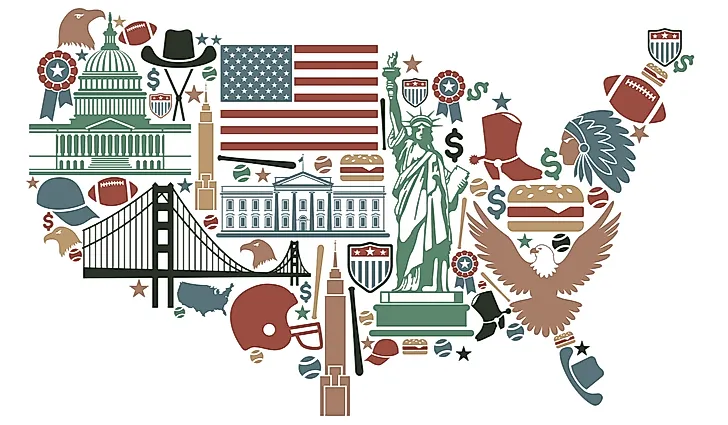Earlier today, I came across a social media discussion in which someone asked, “What is American culture?” What followed was a wave of sarcastic replies, many simply answering, “What culture?” The implication was clear: that the United States lacks a cultural identity of its own. The tone ranged from dismissive to amused, as if American culture were either invisible or too shallow to count. It is a familiar refrain, one that resurfaces in global conversations and intellectual debates, often reflecting a narrow or Eurocentric view of what culture is supposed to look like.
Later, while watching a show, I heard Billie Holiday’s haunting rendition of “I’ll Be Seeing You.” The song, with its fragile intimacy and understated ache, reached across time. In that moment, I thought: This is American culture. Not always ancient. Not always refined. But alive, emotional, and deeply human.
Culture: A Living Fabric of Expression
Before we can answer whether the United States has culture, we must first interrogate what we mean by culture. Is it a body of centuries-old traditions, passed down unchanged across generations? Is it language, cuisine, ritual? Or is it something more fluid, something that evolves, that reacts to the world, and that reflects who a people are in any given moment?
Anthropologists define culture as a system of shared symbols, practices, values, and meanings. It manifests in language, in music, in institutions, in everyday routines. By this definition, American culture is not only present: it is complex, layered, and influential. But it also resists singular definitions. It is pluralistic by nature, built through immigration, conflict, imagination, and reinvention. The United States is one of the few places where culture is as much about what you carry with you as it is about what you find when you arrive.
The Musical Soul of a Nation
Take Billie Holiday as one example; not simply a singer, but a voice of an era. “I’ll Be Seeing You” became a wartime anthem, encapsulating the emotional toll of separation during World War II. It is a song about absence and longing, but also about hope. Holiday’s phrasing, her near-whispers, her drawn-out syllables are as much emotional testimony as musical technique. She, like many African American artists of her time, helped birth a uniquely American art form: jazz.
Jazz, blues, rock and roll, country, gospel, hip hop, each of these genres originated in the United States, often in marginalized communities, often in struggle. They tell stories that formal histories neglect. Jazz was born out of African rhythms and European harmonies, nurtured in New Orleans, and spread through smoky clubs and urban nightscapes. Hip hop, emerging from the Bronx in the 1970s, gave voice to disenfranchised youth through rhythm, poetry, and protest. These are not cultural accidents; they are cultural responses to injustice, to migration, to urbanization, and to longing for connection. To dismiss them is to dismiss how culture is made.
Cultural Identity in the Form of Food
If music reflects the emotional pulse of a nation, food reflects its geography, migration, and memory. American cuisine may not always be haute, but it is rich in regional variation and historical resonance. Consider Southern soul food: a culinary tradition born from African, Native American, and European influences, rooted in histories of slavery and resilience. Fried chicken, cornbread, collard greens, each dish tells a story of survival and adaptation.
Or consider the humble diner. More than just a place to eat, the American diner is a cultural institution. With its vinyl booths, chrome accents, bottomless coffee, and laminated menus, the diner offers a kind of egalitarian ritual, a place where truck drivers, students, artists, and retirees share the same space. It reflects one of the ideals of American culture: openness. There is no dress code. No social gatekeeping. Just a booth, a plate, and a sense of belonging.
From Tex-Mex to bagels with lox, from clam chowder to jambalaya, American food is a map of its immigrants. The culture is not always in the ingredients, but in the fusion, the adaptation, the story of what happened when one culture met another on the same kitchen table.
Ideals, Contradictions, and the American Imagination
Every culture is defined not only by its accomplishments but also by its contradictions. American culture is built upon ideals: freedom, democracy, individualism, reinvention. But these ideals have never existed in a vacuum. They have coexisted with slavery, exclusion, systemic racism, economic inequality, and environmental degradation. And yet, what is remarkable is how American culture has persistently grappled with these contradictions through its literature, its protests, its films, and its academic discourse.
To read James Baldwin, to watch Spike Lee, to walk through the National Museum of African American History and Culture, is to understand that culture is also a process of reflection and reckoning. The culture is in the struggle itself, in the demand to reconcile ideals with reality. It is in the courage to critique one’s own myths while still hoping for a better future.
Hollywood: America’s Global Imagination Machine
No discussion of American culture would be complete without addressing Hollywood. More than an industry, Hollywood is a cultural engine, one that has shaped how the world sees America and, often, how America sees itself. For over a century, it has exported not only entertainment but ideals, archetypes, and narratives that have become embedded in global consciousness.
Hollywood tells stories on a scale few nations can rival. Westerns mythologized the frontier spirit. Noir films captured the anxieties of postwar disillusionment. Blockbusters like Star Wars and The Matrix became modern epics, mirroring philosophical and political dilemmas in the language of lasers and rebellion. Even romantic comedies set in New York apartments far larger than anyone could afford project a fantasy of urban life infused with optimism and charm.
But Hollywood is not merely about fantasy. It is also about aspiration. It has long functioned as a mirror to American dreams and discontents. Films like 12 Years a Slave, Get Out, Nomadland, and Everything Everywhere All At Once challenge viewers to reckon with history, race, class, identity, and mental health. Hollywood, for all its excesses and commercialism, remains one of the most powerful storytelling institutions in the world, and it is distinctly American.
At its best, Hollywood demonstrates how culture operates as both soft power and social conscience. It entertains, yes, but it also provokes, heals, unites, and occasionally subverts. In doing so, it performs an essential function of any culture: to imagine what is possible, and to critique what is real.
A Culture So Present, It Becomes Invisible
Perhaps the question “What culture?” arises precisely because American culture is so omnipresent. It has become part of the global background noise. Hollywood films set global standards for storytelling. American television reshaped formats across continents. Blue jeans, rap music, fast food, Netflix, memes, these are part of the global lexicon now. American culture is not absent; it is everywhere, often so embedded in global culture that it is no longer recognized as American.
Yet this ubiquity should not be mistaken for homogeneity or shallowness. Beneath the surface lies depth: stories of migration and trauma, triumph and reinvention. The fact that millions of people across the world can name a U.S. president, sing a pop song, or quote a sitcom is evidence of cultural power. Whether one sees that as a good or bad thing is a different conversation, but it is, unmistakably, culture.
A Personal Reflection: The Jazz Note That Lingers
As a Romanian-American academic, I move between worlds. I have spent years observing how different societies define and defend their cultural heritage. In Romania, culture is often rooted in centuries of language, religion, and folk tradition. It is tangible, historical, and proudly preserved. In contrast, American culture is more fluid, more performative, more self-aware. It builds itself in real time. It is less about ancestry and more about affinity.
Still, it is no less meaningful. That moment when Billie Holiday’s voice filled the room, soft, mournful, defiant, I was reminded that American culture is not a static set of artifacts. It is a moment. A feeling. A connection that echoes across decades. The echo of a jazz note. The glow of a neon diner. The rhythm of possibility.
Conclusion: Culture, Reinvented
So, what is American culture?
It is the soundtrack of Billie Holiday, the resilience of a jazz riff, the comfort of a diner at 2 a.m., the language of reinvention, and the persistence of ideals through imperfection. It is the camera lens of Hollywood, projecting dreams and discontents across continents, creating a shared space of imagination. American culture is not ancient in the traditional sense. It is modern, pluralistic, and continuously unfolding.
It is in its contradictions. It is in its collisions. And most of all, it is in its belief that culture is not only inherited; it is made. Made in studios and street corners, in protests and poetry, in communities that challenge and recreate what it means to belong.
So the next time someone asks, “What culture?”, perhaps the better question is: Which one? Because in America, culture is not a monolith. It is a mosaic.

